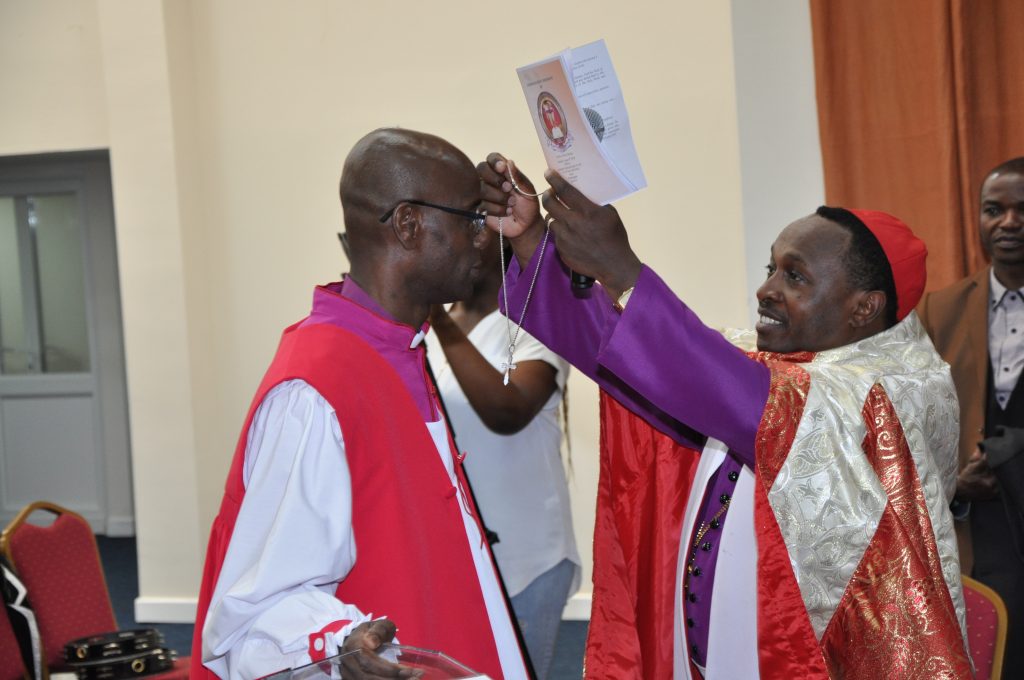Become a Member

Complete your membership application here.
QUALIFICATIONS FOR APPLYING TO BE A BISHOP, APOSTLE OR PROPHET(ESS) WITH CCOEB
Must display a level of loyalty and commitment to the organization.
Must be at least thirty years of age. Consideration is giving where the persons gift is developed earlier in age.
Must maintain a clear criminal record.
Must exhibit the characteristics and virtues that are described in the College’s handbook.
Must not be a novice in Christian doctrine or ministry, but one who has served in leadership capacities within the church.
Must reside in the diocese, or domiciled in the geographical location they are overseeing.
Must have internet access to be able to communicate efficiently for meetings with the Metropolitan.
Must be able to communicate effectively in the English, Spanish or French language.
Must be able to travel internationally in order to attend meetings involving the College of Bishops, Apostles and Prophets.
Must have the financial means to support himself.
Must wear the proper vestments for all CCOEB conferences.
Must have no less than 10 years of ministry experience.
Must have an evangelistic plan for outreach within their diocese.
Must be someone who has been entrusted with the responsibility of guarding and protecting the flock of our Lord Jesus Christ. Our Bishops are assigned the following offices
Patriarch
Patriarchs are the bishops who head certain ancient autocephalous or sui iuris churches, which are a collection of metropolitan sees or provinces.
Primate
A primate is usually the bishop of the oldest church of a nation. Sometimes this carries jurisdiction over metropolitan bishops, but usually it is purely honorific.
Presiding Bishop or President Bishop
These titles are often used for the head of a national Anglican church, but the title is not usually associated with a particular episcopal see like the title of a primate.
Metropolitan bishop
A metropolitan bishop is an archbishop in charge of an ecclesiastical province, or group of dioceses, and in addition to having immediate jurisdiction over his own archdiocese, also exercises some oversight over the other dioceses within that province. Sometimes a metropolitan may also be the head of an autocephalous, sui iuris, or autonomous church when the number of adherents of that tradition are small.
Archbishop
An archbishop is the bishop of an archdiocese. This is usually a prestigious diocese with an important place in local church history.
Suffragan bishop
A suffragan bishop is a bishop subordinate to a Metropolitan.
Our Bishops receives the Apostolic Succession certificate.
The Apostolic Succession is the belief hold that the authority and spiritual lineage of the apostles have been passed down through the generations of bishops by the laying on of hands in consecration.
We trace the succession from:
- Jesus Christ: The founder of Christianity, whose teachings and actions laid the foundation for the faith. He selected the Twelve Apostles to be his closest followers and to continue his mission after his death.
- The Twelve Apostles: Chosen by Jesus, these individuals played a crucial role in spreading his teachings and establishing Christian communities. They were witnesses to his resurrection and carried forward his message.
- Early Christian Leaders: The apostles ordained bishops to oversee local communities and ensure the continuation of the faith. These bishops were seen as the successors to the apostles and were responsible for teaching, guiding, and maintaining unity.
- Episcopal Hierarchy: Over time, a hierarchical structure emerged within the Church, with bishops overseeing various regions. Some of these bishops were associated with major cities or historical centers of Christianity, such as Jerusalem, Antioch, Rome, and Alexandria.
- Regional Patriarchs and Major Sees: Certain bishops gained prominence due to the historical, theological, or political significance of their cities. The bishops of these major sees came to be known as patriarchs or archbishops, and their roles carried special weight within the Church.
- East-West Schism (1054): The Eastern Orthodox Church and the Roman Catholic Church split in what is known as the Great Schism. One of the key points of contention was the authority of the Bishop of Rome (the Pope) over the entire Church. This marked the beginning of separate developments in apostolic succession for the Eastern and Western traditions.
- Papal Primacy: In the Roman Catholic tradition, the Pope’s authority was emphasized, and he is considered the supreme pontiff and successor of Peter, one of the Twelve Apostles.
- Eastern Orthodox Succession: The Eastern Orthodox Church maintains apostolic succession through an unbroken chain of bishops in various patriarchates and autocephalous churches. Each bishop is consecrated by the laying on of hands by other bishops, thus maintaining the spiritual lineage.
- Anglican Apostolic Succession: The Anglican Communion claims apostolic succession through the historic episcopate, tracing back to the apostles. However, the validity of this succession is not universally recognized, particularly by the Roman Catholic Church.
- Oriental Orthodox and Other Churches: Various other branches of Christianity, such as the Oriental Orthodox Churches (Coptic, Armenian, etc.) and the Assyrian Church of the East, also uphold the concept of apostolic succession in their own unique ways.
- Modern Developments: Apostolic succession continues to be a central aspect of the high-church traditions, shaping their theology, liturgy, and ecclesiastical structures. However, interpretations of its significance can vary within and between denominations.
It’s important to recognize that while apostolic succession is a concept shared by many traditional Christian denominations, there are differences in how it’s understood and practiced within each tradition. These differences can include variations in liturgical practices, theological nuances, and the role of bishops and clergy in each tradition’s hierarchy.
